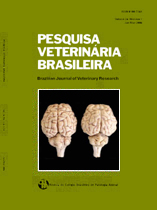 |
|
|
|
Year 2011 - Volume 31, Number 11
|

|
Anti-Rickettsia spp. antibodies in free-ranging and captive capybaras from southern Brazil, 31(11):1014-1018
|
ABSTRACT.- Fortes F.S., Santos L.C., Cubas Z.S., Barros-Filho I.R., Biondo A.W., Silveira I., Labruna M.B. & Molento M.B. 2011. Anti-Rickettsia spp. antibodies in free-ranging and captive capybaras from southern Brazil. Pesquisa Veterinária Brasileira 31(11):1014-1018. Departamento de Medicina Veterinária, Setor de Ciências Agrárias, Universidade Federal do Paraná, Rua dos Funcionários 1540, Juvevê, Curitiba, PR 80035-050, Brazil. E-mail: molento@ufpr.br
Capybaras (Hydrochaeris hydrochaeris) are among the main hosts of Amblyomma spp. ticks, which is able to transmit Rickettsia species to human beings and animals. Since they are often infested with potential vector ticks, capybaras may be used as sentinels for rickettsiosis, such as the Brazilian Spotted Fever. The aim of the present study was to determine the prevalence of antibodies against Rickettsia spp. using the indirect immunofluorescence assay (IFA) in 21 free-ranging and 10 captive animals from the Zoological Park of the ‘Bela Vista Biological Sanctuary’ (BVBS), Itaipu Binational, Foz do Iguaçu, Southern Brazil. Antigens of six rickettsial species already identified in Brazil (Rickettsia rickettsii, R. parkeri, R. bellii, R. rhipicephali, R. amblyommii and R. felis) were used for IFA. Ticks from each capybara were collected for posterior taxonomic identification. A total of 19 (61.3%) samples reacted to at least one of tested species. Seropositivity was found in 14 (45.2%), 12 (38.7%), 5 (16.1%), 4 (12.9%), 3 (9.7%) and 3 (9.7%) animals for R. rickettsii, R. bellii, R. parkeri, R. amblyommii, R. felis and R. rhipicephali, respectively. Two captive capybaras presented suggestive titers of R. rickettsii infection and one sample showed homologous reaction to R. parkeri. Only one free-ranging capybara presented evidence R. bellii infection. Ticks collected on capybaras were identified as Amblyomma dubitatum e Amblyomma sp. Results evidenced the rickettsial circulation in the area, suggesting a potential role of capybaras on bacterial life cycle. |
| |
|
|
| |
|
 |